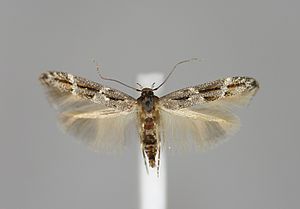Mompha sturnipennella
| Mompha sturnipennella | ||||||||||||
|---|---|---|---|---|---|---|---|---|---|---|---|---|

Mompha sturnipennella , male |
||||||||||||
| Systematics | ||||||||||||
|
||||||||||||
| Scientific name | ||||||||||||
| Mompha sturnipennella | ||||||||||||
| ( Treitschke , 1833) |
Mompha sturnipennella is a butterfly ( moth ) fromthe fringed moth family (Momphidae).
features
The moths reach a wingspan of 9 to 13 millimeters. The head is mottled gray and light gray. The thorax is dark gray. The forewings are dark gray and lighter from the wing base to about 2/5 of the forewing length. In front of the middle of the wing is a white, heavily speckled gray band that runs slightly outwards. It doesn't quite reach the Costa loader and widens to the inner edge of the wing. A white, inward-running band is in the last quarter of the forewing. Black lines exist in the anal fold, in the middle area between both bandages and in the apical area. The medial black line is often framed in white on the dorsal side, and rust-colored lines or scales border the two outer lines . A small black tuft of slightly protruding scales is located on the first fifth of the forewing length, a second and third are located on the outer edge of the white bandages. The apical area of the Costa loader is drawn with two or three white lines. The hind wings have a brownish gray sheen.
In the male, the cucullus has a broad base. It is slightly curved in the middle, the apex is wide and rounded. The saccule tapers gradually to a blunt point, which is covered with three to five small teeth. The uncus is slender and has a dilated subapical area. The gnathos is rounded. The anellus lobes are very small and rounded. The Aedeagus has a large and curved cornutus, several short and strong and a number of slender cornuti. The shape of the cucullus and the cornuti are characteristic of the species.
In females, the antevaginal lamella consists of two wedge-shaped sclerites and a large, elongated oval sclerotization in between. The vaginal sinus is large and cup-shaped. The ductus bursae is short and indistinctly sclerotized . In the posterior section, the corpus bursae has two toothy spots. It is wrinkled and slightly curved in the middle. The shape of the antevaginal lamella and the ductus bursae are characteristic of the species.
Similar species
The similar species Mompha subbistrigella basically has the same wing markings as Mompha sturnipennella , but the rust-colored lines in the middle of the forewing and the clear white costal lines in the apical area are missing.
distribution
Mompha sturnipennella is distributed Holarctic and occurs in Europe (with the exception of the south) in Siberia and in the Russian Far East . The species was also found in Canada .
biology
The caterpillars of the first generation develop from May to June, those of the second generation from July to August on narrow-leaved willowherb ( Chamaenerion angustifolium ). As a result of the caterpillars' feeding activity, gall-like swellings of the stem occur, these are spindle-shaped and are usually located in the flowering part of the stem. Several galls can be formed on one stem. The second generation caterpillars mostly live in the seed pods and only sometimes form plant galls. Infested seed pods can be recognized by a small drill hole. The caterpillars pupate outside of the stem feeding tunnel or outside of the seed capsule. The species forms one generation in the north of the distribution area, two generations in the south. The moths fly from July, overwinter and can be observed again from May of the coming year. The moths are particularly common after wintering.
Systematics
The following synonyms are known from the literature:
- Ornix sturnipennella Treitschke , 1833
- Oecophora modestella Eversmann , 1844
- [Mompha] permutatella Herrich-Schäffer , [1854]
- Mompha (Lauerna) nodicolella Fuchs , 1902
swell
Individual evidence
- ↑ a b c d e J. C. Koster, S. Yu. Sinev: Momphidae, Batrachedridae, Stathmopodidae, Agonoxenidae, Cosmopterigidae, Chrysopeleiidae . In: P. Huemer, O. Karsholt, L. Lyneborg (eds.): Microlepidoptera of Europe . 1st edition. tape 5 . Apollo Books, Stenstrup 2003, ISBN 87-88757-66-8 , pp. 38 (English).
- ↑ Karl Traugott Schütze: The biology of the small butterflies with special consideration of their nutrient plants and times of appearance. Handbook of Microlepidoptera. Caterpillar calendar arranged according to the illustrated German Flora by H. Wagner. Frankfurt am Main, publishing house of the International Entomological Association e. V., 1931, p. 144
literature
- Georg Friedrich Treitschke : The butterflies of Europe. Ernst Fleischer, Leipzig 1833, p. 209 (first description)
Web links
- Lepiforum e. V. - Taxonomy and photos
- Ian Kimber: Guide to the moths of Great Britain and Ireland - Photos